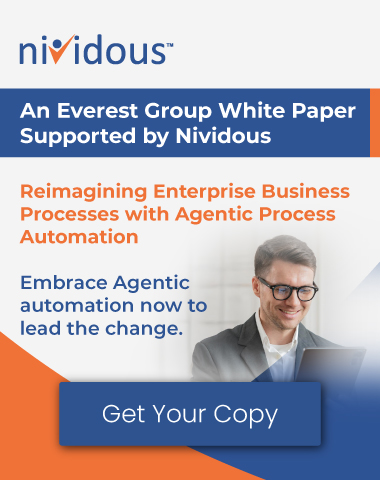Automation shows up in every stack, yet work still stalls at handoffs and exceptions. Rigid flows pause when inputs change. Teams jump in, costs rise, and outcomes drift from intent.
Agentic workflows close that gap. They pursue goals, adapt to live signals, and coordinate multi-step tasks across systems without constant supervision. The payoff is faster decisions, fewer bottlenecks, and results that match business objectives.
Why Current Tools Stall
RPA moves data through known steps but breaks when formats, fields, or screens change. Low-code flow builders connect systems, but they depend on fixed branches. Isolated AI models classify, predict, or extract, yet they do not carry work to completion.
Modern work shifts by the hour. Inputs arrive from new sources. Policies evolve across regions and partners. Teams need automation that weighs options, handles exceptions, and keeps going when the plan changes.
What Agentic Workflows Are
Agentic workflows are software-driven processes that understand goals, plan steps, and adjust execution as conditions change. They combine retrieval, reasoning, and action in a closed loop. Each run records outcomes, so performance improves over time.
Use Agentic workflows to turn static checklists into dynamic flows. The agent chooses the next best action, monitors effects, and continues until the target outcome is reached.
How Agentic Workflows Bridge the Gap
Agentic workflows bring three capabilities that traditional tools miss. They reason about context so decisions align with policy and priority. They adapt to new signals so work does not stop at the first exception. They finish the loop by invoking tools, validating results, and moving to the next step.
Generative AI adds clear summaries and human-readable rationales. Agentic AI manages orchestration, tool choice, and error recovery. Together, they convert analysis into action and keep work moving.
Procurement That Reacts to Supply Signals
Procurement leaders need firm control over cost, lead time, and risk. Spreadsheets and static flows miss supplier delays and shifting terms. Agentic workflows track requisitions from need to receipt with live data.
The agent checks contracts, inventory, and demand forecasts. It evaluates suppliers against quality, price, and delivery risk. When a shipment slips, it proposes alternatives and routes approvals with the right thresholds. Generative AI drafts supplier updates and internal briefings. Teams place orders with confidence and recover faster from disruptions.
Customer Service That Resolves on First Contact
Service decisions drive loyalty every day. Agents need context, guidance, and clear steps that span systems. Agentic workflows bring the full picture to the desktop.
The agent gathers account history, product telemetry, and entitlement data before the reply. It recommends the most likely fix with confidence scores that supervisors can review. It files tickets, triggers returns, adjusts entitlements, and verifies completion. Generative AI drafts responses that match tone and policy. Customers receive accurate answers, while leaders see trends as they form.
Compliance That Scales With Audit-Ready Trails
Compliance programs struggle when controls sit outside daily work. Manual checkpoints slow teams and still miss gaps. Agentic workflows embed controls into the flow.
The agent enforces separation of duties, required fields, and policy checks at each step. It collects evidence, timestamps actions, and stores rationale in one place. generative AI produces narratives that explain decisions in plain language. Auditors review complete trails without recreating the process. Risk drops while throughput rises.
How Agentic Workflows Fit With Your Existing Tools
You keep your systems. Agents connect through APIs and standard connectors. Use RPA where interfaces are missing. Intelligent document processing reads forms, faxes, and PDFs. Workflow automation updates line-of-business systems as steps complete.
This approach avoids rip-and-replace. It adds autonomy step by step. Each completed loop adds telemetry and learning that improves the next loop.
The Stack Behind Agentic Workflows
Expect a modular stack that fits your environment. Start with secure data integration and a semantic layer that defines shared business terms. Add model services for forecasting, classification, retrieval, and optimization.
Use low-code workflow automation to write results back into ERP, CRM, HRIS, ITSM, and billing. Bring in RPA for UI-level steps. Pair generative AI for readable updates with agentic AI for planning and tool use. Agentic workflows tie these parts together so recommendations become tracked actions.
Nividous Named a Major Contender in Everest Group’s IPAP PEAK Matrix® Assessment 2025
Explore the 2025 Intelligent Process Automation Platform (IPAP) PEAK Matrix® Assessment to see how Nividous stands out as a Major Contender with a unified platform for RPA, workflow automation, IDP, generative AI, and agentic AI.
Design Principles and Governance
Strong design and clear governance keep agentic workflows reliable, secure, and compliant. Apply these principles early to reduce rework, speed approvals, and withstand audits.
Start With Outcomes
State the business goal in measurable terms and list hard constraints. Define decision rights, SLAs, and error bands. Encode rules as automated checks and fallback paths before the first pilot.
Make Context First-Class
Create a shared data model that resolves customers, vendors, employees, and products to stable IDs. Normalize dates, amounts, and statuses. Persist memory from prior steps so each action reflects what happened last.
Keep Humans in the Loop
Set thresholds that trigger review and route edge cases to the right role with full evidence attached. Give reviewers one-click approve, edit, or reject options. Let the agent resume work after approval so momentum continues.
Log Everything
Capture inputs, prompts, tools used, outputs, and decisions in structured, timestamped events. Add correlation IDs to trace cases end-to-end. Monitor logs with alerts and dashboards to catch drift or quality issues early.
Protect Access
Enforce role-based permissions and least-privilege integrations. Encrypt data in transit and at rest. Segregate sensitive records and rotate secrets from a vault. Run regular access reviews and automated tests.
Department Playbooks With Excellent Outcomes
These guides show where agentic workflows land value fast. Each one lists core decisions, needed data, and actions the agent can take in your systems.
Finance
Close faster with anomaly checks on journals and reconciliations. Blend historicals with price, seasonality, and pipeline signals to lift forecast accuracy. When variances appear, generative AI explains root causes in plain language, and the agent opens tasks, routes approvals, and confirms completion.
HR
Screen applicants with transparent scoring that hiring managers can audit. Generate interview guides and summaries tied to competencies. During onboarding, the agent coordinates IT access, equipment, and training. New hires reach productivity sooner with clear welcome plans from generative AI.
Operations
Predict demand, schedule labor, and plan production with constraints in view. When reality shifts, the agent rebalances work, updates systems, and notifies stakeholders. Generative AI shares impact, options, and tradeoffs so leaders can decide quickly.
Customer Service
Surface full customer context, recommend likely resolutions, and draft replies that match tone and policy. The agent files tickets, triggers returns, adjusts entitlements, and verifies completion across systems. Knowledge content stays current with cited updates.
Enterprise Use Cases for Measurable Impact
Agentic workflows shine where decisions, handoffs, and exceptions slow teams down. Connect systems, apply policy, keep humans in the loop, and let the agent finish the work.
Customer Onboarding
The agent collects documents and verifies identity. CRM and core records update in the same motion. Risky cases route to a reviewer with a clear summary and required evidence. Deadlines stay visible, nudges go out on schedule, and welcome emails arrive with next steps.
Claims and Cases
Required fields are validated up front, and gaps close with targeted questions. Complete packets go to portals, and decisions are tracked in real time. Denials are grouped by root cause with proposed fixes. Appeals draft in policy language so reviewers can approve with speed.
Quote to Cash
Pricing and availability are read from live data. CRM, ERP, and billing stay in sync as orders advance. Discount and tax rules apply consistently, and approvals reach the right owner. Standard deals flow through, while exceptions follow a guided path with accurate confirmations.
IT and Field Operations
Incidents are triaged with context. Diagnostics run automatically, and runbooks drive the next steps. Technicians schedule when hands are needed. Routes adjust as conditions change, and stakeholders receive brief status notes with the impact and next actions.
Financial Close and Forecast
Anomaly checks run before sign-off. Proposed adjustments reference policy and attach support. Tasks open in the ERP with clear owners and due dates, then close when evidence arrives. Variance narratives from generative AI speed up leadership reviews.
Launch Your Agentic Pilot
See agentic workflows handling onboarding, claims, and service with connected data, generative AI, and agentic AI. Get a guided walkthrough and leave with a pilot plan and success metrics.
How Agentic Workflows Integrate With Nividous
Nividous helps teams move from ideas to outcomes with intelligent automation that fits real work. The platform brings robotic process automation, workflow automation, intelligent document processing, generative AI, and agentic AI into one place. Data stays connected. Recommendations are explainable. Actions finish inside the systems you already use.
Prebuilt connectors reduce lift across ERP, CRM, HRIS, ITSM, and data warehouses. Integrated governance tracks lineage, access, and rationale in one console. Reusable agent skills and templates let teams clone patterns across departments without restarting from scratch. You can start with one use case and expand with a shared stack that carries lessons forward.
Build Adaptive Automation With Nividous
Agentic workflows turn static automation into adaptive execution. That shift reduces decision latency, keeps policies in force, and preserves context from start to finish. It also raises confidence in outcomes because each step is visible and explainable.
See Agentic Workflows in Action
Schedule a guided demo tailored to your finance, HR, operations, or service scenario. We will map your data sources, show explainable plans, and outline the automated steps that follow with generative AI and agentic AI. You will leave with a pilot plan, a timeline, and clear success metrics.





